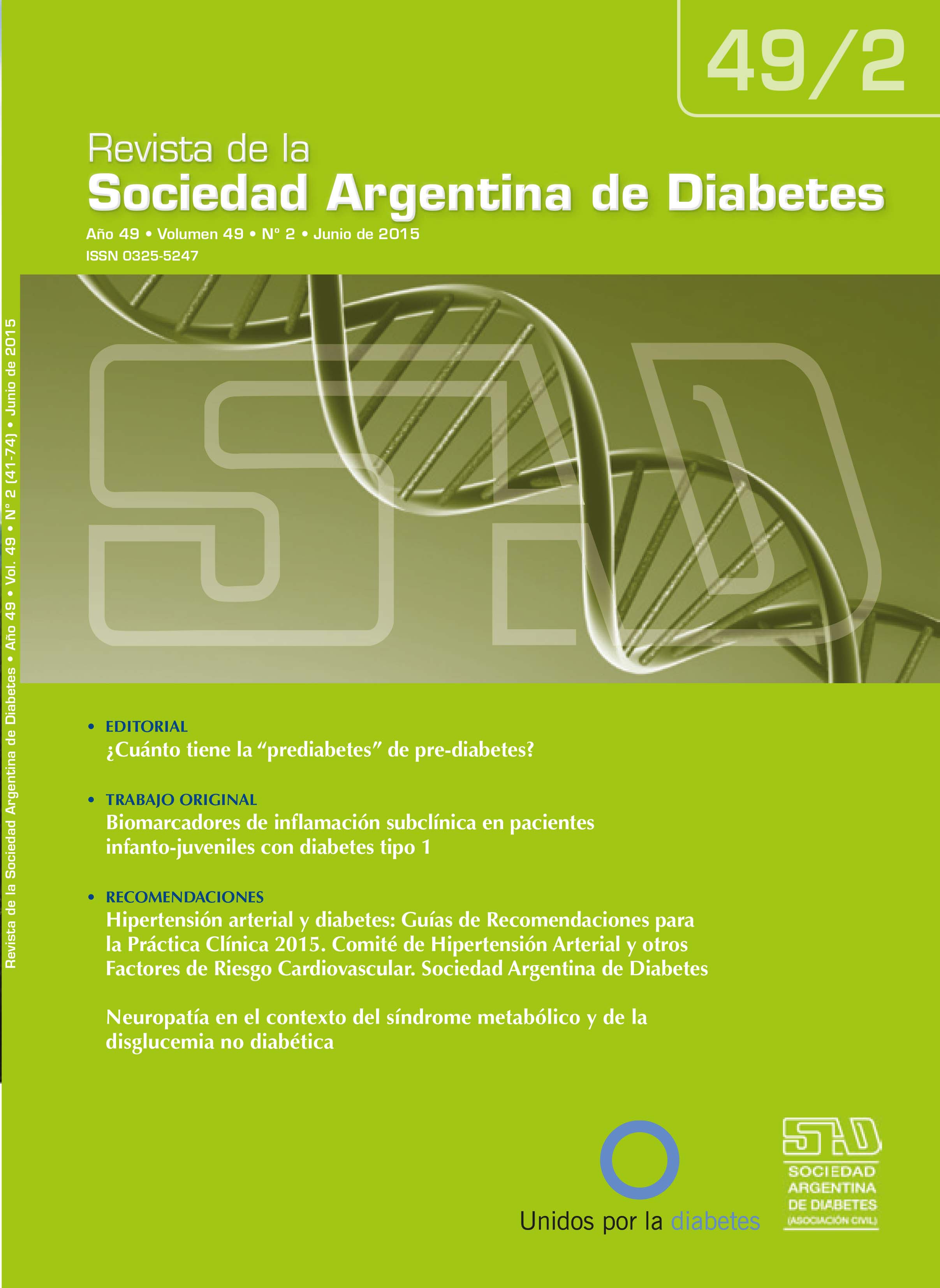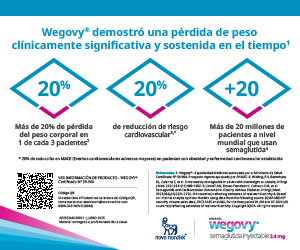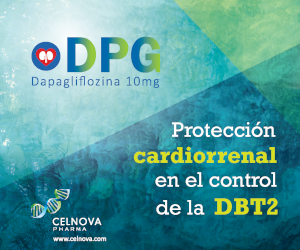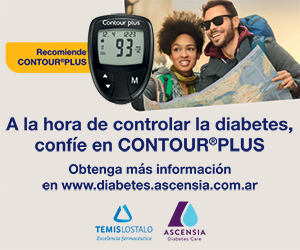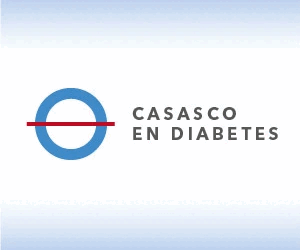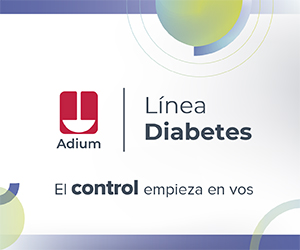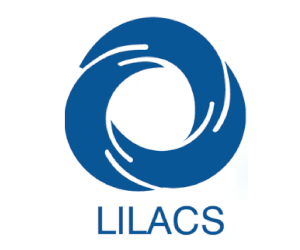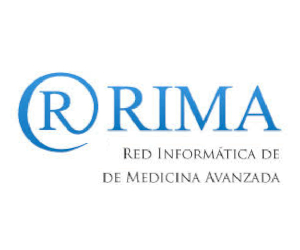Hipertensión arterial y diabetes: guías de recomendaciones para la práctica clínica 2015. Comité de hipertensión arterial y otros factores de riesgo cardiovascular. Sociedad Argentina de Diabetes
DOI:
https://doi.org/10.47196/diab.v49i2.201Palabras clave:
diabetes, hipertensión arterial, diagnóstico, tratamientoResumen
Introducción: la hipertensión arterial (HA) y la diabetes mellitus (DM) son enfermedades crónicas de alta prevalencia que se encuentran frecuentemente asociadas.
Objetivos: brindar los conocimientos para la práctica clínica que favorezcan la toma de decisiones diagnósticas y terapéuticas adecuadas, basadas en las evidencias científicas actuales.
Materiales y métodos: utilizando la evidencia disponible, los grandes ensayos clínicos publicados en los últimos cuatro años y la adaptación de los recursos diagnósticos y terapéuticos de nuestro país se elaboraron las presentes “Recomendaciones
para la Práctica Clínica”.
Conclusiones: la HA aumenta la progresión y el desarrollo de las complicaciones crónicas micro y macrovasculares de la DM. El impacto del tratamiento de la HA es significativo en la reducción de la morbimortalidad de las personas con DM. Por ello, el tratamiento debe ser temprano y las metas de objetivo terapéutico deberán ser individualizadas según grupo etario, comorbilidades y daño de órgano blanco. En todas las personas con HA, tengan o no DM y/o enfermedad renal crónica (ERC), el objetivo es alcanzar una PA <140/90 mmHg.
Podrán considerarse objetivos más cercanos a 130/80 mmHg en jóvenes, sin comorbilidades, con larga expectativa de vida y menor tiempo de diagnóstico de DM: en quienes tendrían beneficios a nivel renal o en quienes el riesgo de ACV es sustancial, si se
logran sin efectos adversos asociados al tratamiento. Los IECA o ARA II son los fármacos de primera elección excepto en casos de intolerancia o contraindicación. Un bajo porcentaje de personas
logra el objetivo terapéutico. La educación es una herramienta fundamental para mejorar la adherencia al tratamiento.
Citas
OMS 2013. A global brief on hypertension. Hypertension: the basic facts. Disponible en:http://apps.who.int/iris/bitstream/10665/79059/1/WHO_DCO_WHD_2013.2_eng.pdf
ENFR 2005. Disponible en: http://www.msal.gov.ar/ent/images/stories/vigilancia /pdf/ encuesta_ factores_riesgo_2005_completa.pdf.
ENFR 2009. Disponible en: http://www.msal.gov.ar/ent/images/stories/vigilancia /pdf/segunda_ encuesta_nacional_de_factores_de_riesgo_2011.pdf.
ENFR 2013. Disponible en: http://www.msal.gov.ar/images/stories/bes/graficos/ 0000000544cnt-2014-09_3er-encuesta-nacional-factores-riesgo.pdf.
Committee for Practice Guidelines (CPG) of the European Society of Cardiology (ESC) Recommendation for Guidelines production. A document for Task Force Members Responsible for the Production and Updating of ESC Guidelines: Disponible en:http://www.escardio.org/static_file/Escardio/Guidelines/ESC%20Guidelines%20for%20Guidelines%20Update%202010.pdf.
Lapertosa S, González C, Benítez J, y col. Prevalencia de diabetes mellitus tipo 2 en población adulta de Gobernador Virasoro, Provincia de Corrientes. Rev. ALAD. 2009, Vol. XVII - Nº 3: 89-96.
Coghlan E, Bella Quero L, Schwab M, y col. Prevalencia de hipertensión arterial en una comunidad aborigen del norte argentino. Medicina (Buenos Aires) 2005; 65:108-112.
Gamarra J, Quintana M, Unsain M, y col. Prevalencia de hipertensión arterial en una comunidad aborigen Qom de la Ciudad de Formosa. Revista de Posgrado de la VIº Cátedra de Medicina. 2011; N° 210: 5-6.
Casagrande S, Fradkin J, Saydah S, Rust K, Cowie C. The prevalence of meeting A1C, blood pressure, and LDL goals among people with diabetes, 1988-2010. Diabetes Care 2013; 36:2271-2279.
Ali MK, BullardK M, Saaddine JB, et al. Achievement of goals in U.S. Diabetes Care, 1999-2010. N. Engl. J. Med. 2013; 368:1613-1624.
Vinagre I, Mata-Cases M, Hermosilla E, et al. Control of glycemia and cardiovascular risk factors in patients with type 2 diabetes in primary care in Catalonia (Spain). Diabetes Care 2012; 35:774-779.
Teoh T, Despres JP, Dufou A, et al. Comparison of the assessment and management of cardiometabolic risk in patients with and without type 2 diabetes mellitus in Canadian primary care. Diabetes, Obesity and Metabolism 2013; 15:1093-1100.
Ruiz Morosini ML, López González E, García A. On behalf of Grupo FRADYC I. Arterial hypertension multicentric study in type 2 diabetic patients. World Congress of Cardiology, 2008. Circulation, Sep. 2008; 118: e162 - e413.
García A, Luongo A, López González E, y col. ¿Qué factores correlacionan con el control de la hipertensión arterial en personas con diabetes mellitus tipo 2?. Actas 40º Congreso Argentino de Cardiología, Buenos Aires, Octubre 2014. Premio Dr. Eduardo Braun Menéndez al mejor trabajo en hipertensión arterial clínica. Disponible en: http://www.sac.org.ar/40-congreso-argentino-de-cardiologia/temas-libres/.
Purnell J, Hokanson JE, Cleary P, et al. The effect of excess weight gain with intensive diabetes mellitus treatment on cardiovascular disease risk factors and atherosclerosis in type 1 diabetes mellitus. Circulation 2013;127:180-187.
Maahs D, Kinneyg, Wadwa P, et al. Hypertension prevalence, awareness, treatment, and control in an adult type 1 diabetes population and a comparable general population. Diabetes Care 2005; 28:301-306.
López González E, Ruiz Morosini ML, Houssay S y Grupo Fradyc DM1. Factores de riesgo cardiovascular y obesidad en pacientes con diabetes mellitus tipo 1 en Argentina. Acta XIX Congreso Argentino de Diabetes. Mar del Plata, noviembre 2014.
American Diabetes Association. Standards of medical care in diabetes-2015. Diabetes Care 2015;38 (S1):1-90.
Majul C, Bendersky M, Diaz M, y col. Consenso de Hipertensión Arterial. Consejo Argentino de Hipertensión Arterial “Dr. Eduardo Braun Menéndez”. Rev. Arg. Cardiol. 2013; 81 (Suppl 2):1-72.
Clinical Practice Guidelines for the Management of Hypertension in the Community: A Statement by the American Society of Hypertension and the International Society of Hypertension. J. of Hypertension 2014; 32:33-15.
Mancia G, Fagard R, Narkiewicz K, et al. ESH/ESC Guidelines for the management of arterial hypertension: the task force for the management of arterial hypertension of the European Society of Hypertension (ESH) and the European Society the Cardiology (ESC). Eur. Heart J. 2013; 34:2159-2259.
López-Jaramillo P, Sánchez R, Díaz M, et al. Consenso latinoamericano de hipertensión en pacientes con diabetes tipo 2 y síndrome metabólico. Clin. Invest. Arterioscl. 2014; 26(2):85-103.
James PA, Oparil S, Carter BL, et al. 2014 Evidence- based guideline for the management of high blood pressure in adults: report from the panel membersappointed to the Eighth Joint National Committee (JNC 8). JAMA 2014; 311(5):507-520.
Fagard RH, Cornelissen VA. Incidence of cardiovascular events in white-coat, masked and sustained hypertension vs. true normotension: a meta-analysis. J. Hypertens. 2007; 25:2193-2198.
Wijkman M, Lanne T, Engvall J, et al. Masked nocturnal hypertension: a novel marker of risk in type 2 diabetes. Diabetologia 2009; 52:1258-1264.
Carey RM. Resistant hypertension. Hypertension 2013; 61:746-750.
Frechtel G, Litwak L, Faingold MC, y col. Guía del tratamiento de la diabetes mellitus tipo 2. Sociedad Argentina de Diabetes A.C. Disponible en: http://www.diabetes.org.ar/wp _SAD_Guia_del_Tratamiento_de_la_DM2.pdf.
Lewington S, Clarke R, Qizilbash N, et al. Age-specific relevance of usual blood pressure to vascular mortality: a meta-analysis of individual data for one million adults in 61 prospective studies. Prospective Studies Collaboration. Lancet 2002; 360:1903-1913.
Chobanian AV, Bakris GL, Black HR, et al. National Heart, Lung, and Blood Institute Joint National Committee on Prevention, Detection, Evaluation, and Treatment of High Blood Pressure; National High Blood Pressure Education Program Coordinating Committee. The Seventh Report of the Joint National Committee on Prevention, Detection, Evaluation, and Treatment of High Blood Pressure: the JNC 7 report. JAMA 2003;289:2560-2572.
Cushman WC, Evans GW, Byington RP, et al. ACCORD Study Group. Effects of intensive blood-pressure control in type 2 diabetes mellitus. N. Engl. J. Med. 2010; 362(17):1575-1585.
Ambrosioni E, Burnier M, Caufield MJ, et al. Reappraisal of European guidelines on hypertension management: a European Society of Hypertension Task Force document. J. Hypertens. 2009; 27:2121-2158.
Zanchetti A, Grassi G, Mancia G. When should antihypertensive drug treatment be initiated and to what levels should systolic blood pressure be lowered? A critical reappraisal. J. Hypertens. 2009; 27:923-934.
Bangalore S, Kumar S, Lobach I, et al. Blood pressure targets in subjects with type 2 diabetes mellitus/impaired fasting glucose: observation from traditional and Bayesian random-effects meta-analysis of randomized trials. Circulation 2011; 123:2799-2810.
Reboldi G, Gentile G, Angeli F, et al. Effects of intensive blood pressure reduction on myocardial infarction and stroke in diabetes: a meta-analysis in 73,913 patients. J. Hypertens. 2011; 29:1253-1169.
Bakris GL. Recognition, pathogenesis, and treatment of different stages of nephropathy in patients with type 2 diabetes mellitus. Mayo Clin. Proc. 2011; 86:444-456.
Flynn C, Bakris G. Blood pressure targets for people with diabetes or chronic kidney disease. Curr. Hypertens. Rep. 2011; 13:452-455.
KDIGO Clinical Practice Guideline for the Management of Blood Pressure in Chronic Kidney Disease. Blood pressure management in kidney transplant recipients (CKD T) Kidney International Supplements 2012; 2:370-371.
Stern A, Sachdeva S, Kapoor R, et al. High blood pressure in dialysis patients: cause, pathophysiology, influence on morbidity, mortality and management. J. Clin. Diagn. Res. 2014; 8(6):ME01-4.
Gutiérrez-Adrianzén OA, Moraes MEA, Almeida AP, et al. Pathophysiological, cardiovascular and neuroendocrine changes in hypertensive patients during the hemodialysis session. Journal of Human Hypertension, 23 October 2014 ldoi:10.1038/jhh.2014.93.
Patel A, ADVANCE Collaborative Group, MacMahon S, Chalmers J, Neal B, Woodward M, et al. Effects of a fixed combination of perindropil and indapamide on macrovascular and microvascular outcomes in patients with type 2 diabetes mellitus (the ADVANCE trial). Lancet 2007; 370: 829-840.
ACCORD Study group. Effects of intensive blood-pressure control in type 2 diabetes mellitus. N. Engl. J. Med. 2010;362:1575-1585.
Franz H, Messerli MD, Mancia G, et al. Dogma disputed: can aggressively lowering blood pressure in hypertensive patients with coronary artery disease be dangerous? Ann. Intern. Med. 2006; 144:884-893.
Mancia G, Schumacher H, Redon J, et al. Blood pressure targets recommended by guidelines and incidence of cardiovascular and renal events in the ongoing telmisartan alone and in combination with ramipril global endpoint Trial (ONTARGET). Circulation 2011;124:1727-1736.
Prevención de las enfermedades cardiovasculares. Guía de bolsillo para la estimación y el manejo del riesgo cardiovascular. Ministerio de Salud de la Nación. www.msal.gov.ar.
Frye L, Phyllis A, Mori Brooks M. On behalf the Bari 2D Study Group. A randomized trials of therapies for type 2 diabetes and coronary artery disease. N. Engl. J. Med. 2009; 360 (24):2503-2515.
Wackers FJ, chyun DA, Young LH. For the detection of ischemia in asymptomatic diabetics (DIAD) investigators. Resolution of asymptomatic myocardial ischemia in patients with type 2 diabetes in the Detection of Ischemia in Asymptomatic Diabetics (DIAD) Study. Diabetes Care 2007;30:2892-2898.
Yusuf S, Hawken S, Ounpuu S, et al. Effect of potentially modifiable risk factors associated with myocardial infarction in 52 countries (the INTERHEART study): case-control study. Lancet 2004; 364:937-952.
Koon Teo PhD, Clara K. Chow, et al. The PURE Investigators-Writing group Hamilton, Ontario, Canada; and Bangalore, India. The Prospective Urban Rural Epidemiology (PURE) study: examining the impact of societal influences on chronic noncommunicable diseases in low-, middle-,and high-income countries. Am. Heart J. 2009; 158:(1)1-7.
Gilles Montalescot, Udo Sechtem, Achenbach S, et al. ESC Guidelines Addenda. 2013 ESC guidelines on the management of stable coronary artery disease-addenda of the European Society of Cardiology. European Heart Journal 2013,1-32.
Canadian Hypertension Education Program (CHEP) 2014. Recommendations Canadian Journal of Cardiology 2014; 30 (5):485-501.
National Standards for Diabetes Self-Management Education and Support -2014, Diabetes Care 2014; 37(Suppl 1): S144-S153.
Evert A, Boucher J, Cypress M. Nutrition therapy recommendations for the managament of adults with diabetes. Diabetes Care 2014; 37 (Suppl 1) S120-S143.
International Diabetes Federation. Managing older people with type 2 diabetes. Global Guideline. Disponible en http://www.idf.org/sites/default/files/IDF-Guideline-for-older-people-T2D.pdf.
Graudal NA, Hubeck-Graudal T, Jurgens G. Effects of low-sodium diet vs. high-sodium diet on blood pressure, renin, aldosterone, catecholamines, cholesterol and triglyceride (Cochrane Review). Am. J. Hypertens 2012; 25:1-15.
Thomas MC, Moran J, Forsblom C, et al. The association between dietary sodium intake, ESRD and all cause mortality in patients with type 1 diabetes. Diabetes Care 2011; 34 (4) 861-866.
Ekinci EI, Clarke S, Thomas MC, et al. Dietary salt intake and mortality in patients with type 2 diabetes. Diabetes Care 2011; 34(3):703-709.
Tablas de composición de alimentos-SEOM. Disponible en: www.seom.org/ seomcms/images/stories/ recursos/anexo_08.pdf.
Tabla de composición química de alimentos. Disponible en: www.nutrinfo.com /tabla_-composicion_quimica_alimentos.php.
Núñez-Córdoba JM, Martínez-González MA, Bes-Rastrollo, et al. Consumo de alcohol e incidencia de hipertensión en una cohorte mediterránea: el estudio SUN. Rev. Esp. Cardiol. 2009; 62:633-641.
Neter JE, Stam BE, Kok FJ, et al. Influence of weight reduction on blood pressure: a meta-analysis of randomized controlled trials. Hypertension 2003; 42:878-884.
Harsha DW, Lin PH, Obarzanek E, et al. DASH Collaborative Research Group. Dietary Approaches to Stop Hypertension: a summary of study results. J. Am. Diet Assoc. 1999; 99(Suppl.):S35-S3.
Heising ETA. The mediterranean diet and food culture: a symposium. Eur. J. Clin. Nutr. 1993; 47:1-100.
Craig WJ, Mangels AR. American Dietetic Association. Position of the American Dietetic Association: vegetarian diets. J. Am. Diet. Assoc. 2009; 109:1266-1282.
Brehm BJ, Lattin BL, Summer SS, et al. One-year comparison of a high monounsaturated fat diet with high carbohydrate diet in type 2 diabetes. Diabetes Care 2009; 32:215-220.
Foundations of Care: education, nutrition, psysical activity, smoking cessation, psychosocial care, and inmunization. Diabetes Care, 2015; 38 (Suppl 1);S20-S30.
Fagard RH. Exercise therapy in hypertensive cardiovascular disease. Prog. Cardiovasc. Dis. 2011; 53: 404-411.
Leitzmann MF, Park Y, Blair A, et al. Physical activity recommendations and decreased risk of mortality. Arch. Lntern. Med. 2007; 167:2453-2460.
Rossi A, Dikareva A, Bacon SL, et al. The impact of physical activity on mortality in patients with high blood pressure: a systematic review. J. Hypertens. 2012;30: 1277-1288.
Fagard RH. Physical activity, fitness, mortality. J. Hypertens. 2012; 30: 1310-1312.
Molmen-Hansen HE, Stolen T, Tjonna AE, et al. Aerobic interval training reduces blood pressure and improves myocardial function in hypertensive patients. Eur J. Prev. Cardiol. 2012; 19: 151-160.
Steward K. Guías de entrenamiento y ejercicio en diabetes e hipertensión. Jama. 2002; 288:13.1622-1631.
Colberg SR, Sigal RJ, Fernhall B, et al. American College of Sports Medicine; American Diabetes Association. Exercise and type 2 diabetes. The American College of Sports Medicine and the American Diabetes Association: joint position statement. Diabetes Care 2010; 33:2692-2696.
Groppelli A, Omboni S, Parati G, et al. Blood pressure and heart rate response to repeated smoking before and after beta-blockade and selective alpha 1 inhibition. J. Hypertens. 1990; 8 (Suppl 5): S35-40.
Groppelli A, Giorgi DM, Omboni S, et al. Persistent blood pressure increase induced by heavy smoking. J Hypertens 1992; 10: 495-499.
Mann SJ, James GD, Wang RS, et al. Elevation of ambulatory systolic blood pressure in hypertensive smokers. A case-control study. JAMA 1991; 265: 2226-2228.
Lancaster T, Stead L. Physician advice forsmoking cessation. Cochrane Database Syst. Rev. 2004; CD000165.
Cahill K, Stead LF, Lancaster T. Nicotine receptor partial agonists for smoking cessation. Cochrane Database Syst. Rev. 2010; CD006103.
Fiore MC, Jaen CR, Baker TB, et al. Treating tobacco use and dependence: 2008 update. Rockville, MD: Department of Health and Human Services, U.S. Public Health Service, 2008.
Lancaster T, Stead LF. Individual behavioural counselling for smoking cessation. Cochrane Database Syst Rev 2005.
Cahill K, Stead LF, Lancaster T. Nicotine receptor partial agonists for smoking cessation. Cochrane Database Syst. Rev. 2007.
International Diabetes Federation. International consensus position statements for diabetes education. IDF. Consultative Section on Diabetes Education; 2011http://www.idf.org/education/self-management-education.
American Association of Diabetes Educators. Standards for outcome measures of diabetes self-management. Diabetes Educ. 2003; 29:804-816.
Gagliardino JJ, y col. Comité de Educación, DOTA. Normas para el desarrollo de programas de educación sobre la diabetes en América. Rev. Panam Salud Pública/Pan. Am. J. Public Health 2001;10 (5):349-353.
Funnell M, Nwankwo R, Gillard ML, et al. Implementing an empowerment-based diabetes self-management education program. Diabetes Educ. 2005; 31:53-56.
Newman S, Steed L, Mulligan K. Self-management interventions for chronic illness. Lancet 2004; 364:1523-1537.
Boren SA, Fitzner KA, Panhalkar PS, et al. Costs and benefits associated with diabetes education: a review of the literature. Diabetes Educ 2009; 35:72-96.
Haynes RB. Introduction. En: Haynes RB, Taylor DW, Sackett Dl. Editors. Compliance in health care. Baltimore: Johns Hopkins University Press. 1979.
Haynes RB. Interventions for helping patients to follow prescriptions for medications. Cochrane Database of Sistematic Reviews, Issue 1, 2001.
Kripalani S, Yao X, Haynes B. Interventions to enhance medication adherence in chronic medical conditions. Arch Intern Med 2007; 167:540-550.
García A, López González E, Milrad S, on behalf of Grupo FRADYC II. Do type 2 diabetes patients achieve therapeutic goals with medication adherence? Acta 50º EASD Annual Meeting, Viena. 15 - 19 September 2014.
Osterberg L, Blaschke T. Adherence to medication. N. Engl. J. Med. 2005; 353:487– 497.
Rodríguez Chamorro MA, García-Jimenez E, Amariles P, y col. Revisión de tests de medición del cumplimiento terapéutico utilizados en la práctica clínica. Aten. Primaria 2008; 40 (8):413-417.
Alonso MA. Adherencia terapéutica: estrategias y prácticas de mejora. Salud Madrid 2006; 3(8):31-38.
Ho MP, Bryson CL, Rumsfeld JS. Medication adherence: its importance in cardiovascular outcomes. Circulation 2009; 119:3028-3035.
World Health Organization. Adherence to Long-Term Therapies. Evidence for Action. Geneve, World Health Org. 2003. Disponible en: http://whqlibdoc.who.int/publications/2003/9241545992.pdf.
Blackurn DF, Swidrovich J, Lemstra M. Non-adherence in type 2 diabetes: practical considerations for interpreting the literatura. Disponible en: http://dx.doi.org/10.2147/ PPA.S30613.
Kjeldsen S, Hedner T, Jamerson K, et al. Hypertension Optimal Treatment (HOT) Study: home blood pressure in treated hypertensive subjects. Hypertension. 1998; 31:1014-1020.
UK Prospective Diabetes Study Group (UKPDS). Tight blood pressure control and risk of macrovascular and microvascular complications in typediabetes. BMJ 1998; 317:703-13.
Mc Murray J, Cohen Solal A, Dietz R, et al. Practical recommendations for the use of ACE inhibitor, beta-blockers and spironolactone in heart failure. Putting guidelines into practice. Eur. J. Heart Fail. 2001; 3:495-502.
Barnett AH, Bain S, Bouter, P et al. Angiotensin-receptor blockade versus converting–enzyme inhibition in type 2 diabetes and nephropathy. N. Engl. J. Med. 2004; 351:1952-1961.
Pogue J, Taylor W, Sard L, et al. The HOPE Study Investigators. Effects of an angiotensina-converting-enzyme inhibitor, ramipril, on cardiovascular events in high risk patients. N. Engl. J. Med. 2000;342:145-153.
Brenner BM, Cooper ME, de Zeeuw D, et al. Effects of losartan on renal and cardiovascular otcomes in patients with type 2 diabetes and nephropathy (RENAAL). N Engl. J. Med. 2001;345: 861-869.
Persson F, Lewis JB, Lewis EJ, et al. Impact of aliskiren treatment on urinary aldosterone levels in patients with type 2 diabetes and nephropathy: an AVOID substudy. J. Renin Angiotensin Aldosterone Syst. 2012;13(1):118-121.
Giacchetti G, Sechi LA, Rilli S, et al. The rennin-angiotensin-aldosterone system, glucose metabolism and diabetes. Trends endocrinol. and metabol. 2005; 16 (3): 120-126.
Mc Murray JJ, Ostergren J, Swedberg K, et al. Effects of candesartan in patient with chronic heart failure and reduced left-ventricular systolic function taking angiotensin-converting-enzyme inhibitors: the CHARM added trial. LANCET 2003; 362:767-771.
Jandeleit-Dahm KA, Tikellis C, Cooper MD, et al. Why blockade of rennin-angiotensin system reduces the incidence of new-onset diabetes. J. Hypertens. 2005; 23: 463-473.
Andersen NH, Poulsen PL, Mogensen C, et al. Long-term dual blockade with candesartan and lisinopril in hypertensive patient with diabetes: the candesartan and lisinopril microalbuminuria study (CALM II study). Diabetes Care 2005; 28: 273-277.
Niskanen L, Hedner T, Hansson L, et al. and CAPPP Study Group. Reduced cardiovascular morbidity and mortality in hypertensive diabetic patients on first-line therapy with an ACE inhibitor compared with a diuretic/beta blocker-based treatment regimen: a subanalysis of the Captopril Prevention Project. Diabetes Care 2001; 24:2091-2096.
Mann JF, Anderson C, Gao P, et al. ONTARGET investigators. Dual inhibition of the renin-angiotensin system in high-risk diabetes and risk for stroke and other outcomes: results of the ONTARGET trial. J. Hypertens. 2013;31(2):414-421.
Parving HH, Brenner BM, McMurray JJ, et al. ALTITUDE Investigators. Cardiorenal end points in a trial of aliskiren for type 2 diabetes. N. Engl. J. Med. 2012; 367(23):2204-2213.
Gheorghiade M, Böhm M, Greene SJ, et al. Effect of aliskiren on postdischarge mortality and heart failure readmissions among patients hospitalized for heart failure: the ASTRONAUT randomized trial. JAMA. 2013; 309(11):1125-1135.
Dahlöf B, Sever PS, Poulter NR, et al. ASCOT Investigators. Prevention of cardiovascular events with an antihypertensive regimen of amlodipine adding perindopril as required versus atenolol adding bendroflumethiazide as required, in the Anglo-Scandinavian Cardiac Outcomes Trial-Blood Pressure Lowering Arm (ASCOT-BPLA): a multicentrerandomised controlled trial. Lancet 2005; 366:895-906.
Masatsugu H, Iwai M, Lan W, et al. ACE Inhibitor improves insulin resistence in diabetic mouse via bradykinin and nitric oxide. Hypertension 2002; 40:329-334.
Hansson L, Lund-Johansen P, Hedner T, et al. Randomized trial of effects of calcium antagonist compared with diuretic and beta-blockers on cardiovascular morbidity and mortality in hypertension: the Nordic Diltiazem (NORDIL) Study. LANCET 2000;356: 359-365.
Aguilar D, Solomon SD, Lars Købe, et al. Newly diagnosed and previously know diabetes mellitus and 1-year outcomes of acute myocardial infarction. The Valsartan in Acute Myocardial Infarction trial (VALIANT). Circulation 2004; 110:1572-1578.
Daikuhara H, Kikuchi F, Ishida T. The combination of olmesartan and a calcium channel blocker (azelnidipine) or candesartan and a calcium channel blocker (amlodipine) in type 2 diabetic hypertensive patients: the OLCA study. Diab. Vasc. Dis. Res. 2012;9(4):280-286.
Tatti P, Pahor M, Byington RP, et al. Outcome results of the Fosinopril versus Amlodipine Cardiovascular Events Randomized Trial (FACET) in patient with hypertension and NIDDM. Diabetes Care 1998; 21: 579-603.
Furberg CD, Wright JT. Davis BR, et al. ALLHAT Colaborative Research Group Mayor outcomes in high-risk hypertensive randomized to angiotensin-converting enzyme inhibitor or calcium channel blocker versus diuretic: the Antihypertensive and Lipid-Lowering treatment to prevent Heart Attack Trial (ALLHAT). JAMA 2002; 288: 2981-2997.
Bakris G, Briasoulis A, Dahlof B, et al. ACCOMPLISH Investigators. Comparison of benazepril plus amlodipine or hydrochlorothiazide in high-risk patients with hypertension and coronary artery disease. Am. J. Cardiol. 2013; 112:255-259.
Hostetter TH. Prevention of end-stage renal disease due type 2 diabetes. N. Engl. J. Med. 2001; 345:910-912.
Buso C, Fuente G, Jadzinsky M, y col. Hallazgos electrocardiográficos en una población diabética tipo 2 de reciente diagnóstico. Acta XIV Congreso Argentino de Diabetes. Mar del Plata, octubre 2004.
Bakris GL, Fonseca V, Katholi R, et al. Glycemic Effects in Diabetes Mellitus: Carvedilol-Metoprololcomparison in Hypertensives (GEMINI). JAMA 2004;292:2227-2236.
Cruickhank JM. Beta-blockers and diabetes: the bad guys come good. Review. Cardiovasc. Drugs Ther. 2002; 16(5):457-470.
Willenheimer R, van Veldhuisen DJ, Silke B, et al. Effect on survival and hospitalization of initiating treatment for chronic heart failure with bisoprolol followed by enalapril, as compared with the opposite sequence: results of the randomized Cardiac Insufficiency Bisoprolol Study (CIBIS) III. Circulation 2005; 112 (16):2426-2435.
Messerli F, Grossman E, Uri Goldbourt U, et al. Are beta-blockers efficacious as first line therapy for hypertension in the elderly? Systematic review. JAMA 1998; 279:1903-1907.
Krum H, Roecker EB, Mohacsi P, et al. Carvedilol Prospective Randomized Cumulative Survival (COPERNICUS) study group. Effects of initiating carvedilol in patient with severe chronic heart failure. JAMA 2003; 289: 712-718.
Pasanisi F, Imperatore G, Vaccaro O, et al. Effects of a 3 month treatment with terazosin on fasting and postprandial glucose and lipid metabolism in type 2 diabetic patients with hypertension. Nutr. Metab. Cardiovascular Dis.1999 Apr.9 (2):73-77.
Moya A, Crespo JJ, Ayala DE, et al. Effects of time of day hypertension treatment on ambulatory blood pressure and clinical characteristics of patients with type 2 diabetes. Chronobilogy International 2013; 30(1-2):116-131.
- Material suplementario en pag Web: http://www.diabetes.org.ar/espacio-para-el-profesional/opiniones-y-recomendaciones/.
Descargas
Publicado
Número
Sección
Licencia

Esta obra está bajo una licencia internacional Creative Commons Atribución-NoComercial-SinDerivadas 4.0.
Dirección Nacional de Derecho de Autor, Exp. N° 5.333.129. Instituto Nacional de la Propiedad Industrial, Marca «Revista de la Sociedad Argentina de Diabetes - Asociación Civil» N° de concesión 2.605.405 y N° de disposición 1.404/13.
La Revista de la SAD está licenciada bajo Licencia Creative Commons Atribución – No Comercial – Sin Obra Derivada 4.0 Internacional.
Por otra parte, la Revista SAD permite que los autores mantengan los derechos de autor sin restricciones.



